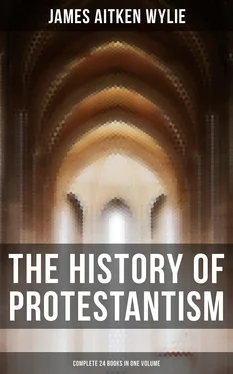The truth, drawn from its primeval fountains, he proclaimed throughout his diocese, which included the valleys of the Waldenses. Where his voice could not reach, he labored to convey instruction by his pen. He wrote commentaries on the Gospels; he published expositions of almost all the epistles of Paul, and several books of the Old Testament; and thus he furnished his contemporaries with the means of judging how far it became them to submit to a jurisdiction so manifestly usurped as that of Rome, or to embrace tenets so undeniably novel as those which she was now foisting upon the world. The sum of what Claude maintained was that there is but one Sovereign in the Church, and He is not on earth; that Peter had no superiority over the other apostles, save in this, that he was the first who preached the Gospel to both Jews and Gentiles; that human merit is of no avail for salvation, and that faith alone saves us. On this cardinal point he insists with a clearness and breadth which remind one of Luther. The authority of tradition he repudiates, prayers for the dead he condemns, as also the notion that the Church cannot err. As regards relics, instead of holiness he can find in them nothing but rottenness, and advises that they be instantly returned to the grave, from which they ought never to have been taken.
Of the Eucharist, he writes in his commentary on Matthew (A.D. 815) in a way which shows that he stood at the greatest distance from the opinions which Paschasius Radbertus broached eighteen years afterwards.
Paschasius Radbertus, a monk, afterwards Abbot of Corbei, pretended to explain with precision the manner in which the body and blood of Christ are present in the Eucharist. He published (831) a treatise, "Concerning the Sacrament of the Body and Blood of Christ." His doctrine amounted to the two following propositions: —
1. Of the bread and wine nothing remains after consecration but the outward figure, under which the body and blood of Christ are really and locally present.
2. This body present in the Eucharist is the same body that was born of the Virgin, that suffered upon the cross, and was raised from the grave.
This new doctrine excited the astonishment of not a few, and called forth several powerful opponents — amongst others, Johannes Scotus. Claudius, however, thought that the Lord's Supper was a memorial of Christ's death, and not a repetition of it, and that the elements of bread and wine were only symbols of the flesh and blood of the Savior. It is clear from this that transubstantiation was unknown in the ninth century to the Churches at the foot of the Alps. Nor was it the Bishop of Turin only who held this doctrine of the Eucharist; we are entitled to infer that the bishops of neighboring dioceses, both north and south of the Alps, shared the opinion of Claude. For though they differed from him on some other points, and did not conceal their difference, they expressed no dissent from his views respecting the Sacrament, and in proof of their concurrence in his general policy, strongly urged him to continue his expositions of the Sacred Scriptures. Specially was this the case as regards two leading ecclesiastics of that day, Jonas, Bishop of Orleans, and the Abbot Theodemirus. Even in the century following, we find certain bishops of the north of Italy saying that "wicked men eat the goat and not the lamb," language wholly incomprehensible from the lips of men who believe in transubstantiation.
The worship of images was then making rapid strides. The Bishop of Rome was the great advocate of this ominous innovation; it was on this point that Claude fought his great battle. He resisted it with all the logic of his pen and all the force of his eloquence; he condemned the practice as idolatrous, and he purged those churches in his diocese which had begun to admit representations of saints and divine persons within their walls, not even sparing the cross itself. It is instructive to mark that the advocates of images in the ninth century justified their use of them by the very same arguments which Romanists employ at this day; and that Claude refutes them on the same ground taken by Protestant writers still. We do not worship the image, say the former, we use it simply as the medium through which our worship ascends to Him whom the image represents; and if we kiss the cross we do so in adoration of Him who died upon it. But, replied Claude — as the Protestant polemic at this hour replies in kneeling to the image, or kissing the cross, you do what the second commandment forbids, and what the Scripture condemns as idolatry. Your worship terminates in the image, and is the worship not of God, but simply of the image. With his argument the Bishop of Turin mingles at times a little raillery. "God commands one thing," says he, "and these people do quite the contrary. God commands us to bear our cross, and not to worship it; but these are all for worshipping it, whereas they do not bear it at all. To serve God after this manner is to go away from Him. For if we ought to adore the cross because Christ was fastened to it, how many other things are there which touched Jesus Christ! Why don't they adore mangers and old clothes, because He was laid in a manger and wrapped in swaddling clothes? Let them adore asses, because He, entered into Jerusalem upon the foal of an ass."
On the subject of the Roman primacy, he leaves it in no wise doubtful what his sentiments were. "We know very well," says he, "that this passage of the Gospel is very ill understood — 'Thou art Peter, and upon this rock will I build my church: and I will give unto thee the keys of the kingdom of heaven,' under pretense of which words the stupid and ignorant common people, destitute of all spiritual knowledge, betake themselves to Rome in hopes of acquiring eternal life. The ministry belongs to all the true superintendents and pastors of the Church, who discharge the same as long as they are in this world; and when they have paid the debt of death, others succeed in their places, who enjoy the same authority and power. Know thou that he only is apostolic who is the keeper and guardian of the apostle's doctrine, and not he who boasts himself to be seated in the chair of the apostle, and in the meantime doth not acquit himself of the charge of the apostle."
We have dwelt the longer on Claude, and the doctrines which he so powerfully advocated by both voice and pen, because, although the picture of his times — a luxurious clergy but an ignorant people, Churches growing in magnificence but declining in piety, images adored but the true God forsaken — is not a pleasant one, yet it establishes two points of great importance. The first is that the Bishop of Rome had not yet succeeded in compelling universal submission to his jurisdiction; and the second that he had not yet been able to persuade all the Churches of Christendom to adopt his novel doctrines, and follow his peculiar customs. Claude was not left to fight that battle alone, nor was he crushed as he inevitably would have been, had Rome been the dominant power it came soon thereafter to be. On the contrary, this Protestant of the ninth century received a large amount of sympathy and support both from bishops and from synods of his time. Agobardus, the Bishop of Lyons, fought by the side of his brother of Turin In fact, he was as great an iconoclast as Claude himself. The emperor, Louis the Pious (le Debonnaire), summoned a Council (824) of "the most learned and judicious bishops of his realm," says Dupin, to discuss this question. For in that age the emperors summoned synods and appointed bishops. And when the Council had assembled, did it wait till Peter should speak, or a Papal allocution had decided the point? "It knew no other way," says Dupin, "to settle the question, than by determining what they should find upon the most impartial examination to be true, by plain text of Holy Scripture, and the judgment of the Fathers." This Council at Paris justified most of the principles for which Claude had contended, as the great Council at Frankfort (794) had done before it. It is worthy of notice further, as bearing on this point, that only two men stood up publicly to oppose Claude during the twenty years he was incessantly occupied in this controversy. The first was Dungulas, a recluse of the Abbey of St. Denis, an Italian, it is believed, and biased naturally in favor of the opinions of the Pope; and the second was Jonas, Bishop of Orleans, who differed from Claude on but the one question of images, and only to the extent of tolerating their use, but condemning as idolatrous their worship — a distinction which it is easy to maintain in theory, but impossible to observe, as experience has demonstrated, in practice.
Читать дальше












